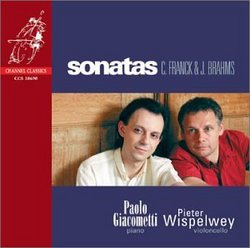| All Artists: Franck, Brahms, Wispelwey, Giacometti Title: Cello Sonatas Members Wishing: 0 Total Copies: 0 Label: Channel Classics Nl Release Date: 10/8/2002 Album Type: Import Genre: Classical Styles: Chamber Music, Historical Periods, Classical (c.1770-1830), Instruments, Strings Number of Discs: 1 SwapaCD Credits: 1 UPC: 723385186984 |
Search - Franck, Brahms, Wispelwey :: Cello Sonatas
 | Franck, Brahms, Wispelwey Cello Sonatas Genre: Classical Contending that the cello literature needs more scope and variety, cellists have always felt free to appropriate and adapt works written for other instruments. However, some pieces are more suitable for transcription than ... more » |
Larger Image |
CD Details
Synopsis
Amazon.com
Contending that the cello literature needs more scope and variety, cellists have always felt free to appropriate and adapt works written for other instruments. However, some pieces are more suitable for transcription than others. So, while arrangements have become an accepted part of the repertoire, they tend to vary in quality. On this disc, Schumann's Adagio and Allegro, written for horn, is more idiomatic to the cello than the two violin sonatas, which, though masterpieces in their original version, do not really lend themselves to successful transplantation. (Not surprisingly, the transcribers are never mentioned.) Both are basically unsuited to the cello's range, necessitating jarring register changes in the most inappropriate places. Moreover, the cello's tone color does not fit much of the music. In the corner movements of the Franck, one misses the shimmering radiance of the high violin register, and in the middle range, the cello is swallowed by the piano and the low notes sound like a growl. The Brahms transcription was always controversial, welcomed only by cellists. To make it more cello-friendly, the key was changed from G-major to D-major, but the cello part still jumps octaves so frequently that melodies are disrupted, moods are not sustained, and climaxes plummet rather than peak. Moreover, the instrumental lines are often redistributed, most distressingly at the very end, where the soaring violin melody sounds flat and prosaic on the piano. The engineering does not help. The balance favors the piano, whose sound is harsh and clangorous. The playing is good technically, and the performers know what they want, but their approach is fussy, sentimental, and exaggerated, with distorted rhythms, excessive dynamics and tempo changes, all calculated and unspontaneous. The pianist perpetuates the frequently encountered misreading of notes in both finales. This recording is not for musical purists. --Edith Eisler
